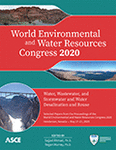World Environmental and Water Resources Congress 2020
Accumulation of Trace Organic Compounds and Antibiotic Resistance Genes in Plants Irrigated with Reclaimed Water
Publication: World Environmental and Water Resources Congress 2020: Water, Wastewater, and Stormwater and Water Desalination and Reuse
ABSTRACT
Treated wastewater is a viable alternative to conventional irrigation water, particularly in arid areas, but it is imperative to understand potential environmental or public health risks associated with this practice, e.g., accumulation of trace organic compounds (TOrCs) in the edible portions of food crops. This study monitors the concentrations of 13 TOrCs in wastewater treated with ultrafiltration (UF) in soils irrigated with these waters. The non-edible and edible portions of spinach and tomato plants grown in soil-based systems irrigated with reclaimed water were analyzed. Two soil-based growth cycles have been completed, where samples have been analyzed for TOrCs uptake. Preliminary data show that under ambient conditions, TOrCs uptake is generally limited to the non-edible portions of tomato plants (9 of 13 compounds detected in soil, 6 compounds in roots, 5 compounds in leaves, and 0 compounds in fruit), and only one compound was detected in spinach leaves (sucralose at 105 ng/g). Even when spiked at 10–50x ambient concentrations, only low levels of benzotriazole, meprobamate, and sucralose were detected in tomato fruit, and this was partially mitigated by sequential irrigation (i.e., reclaimed water followed by tap water at fruiting stage). This study can aid in evaluating the feasibility of widespread implementation of water reuse in agricultural applications, including quantitative information critical to assessing risks associated with TOrCs and antibiotic resistance genes (ARGs) exposure.
Get full access to this article
View all available purchase options and get full access to this chapter.
ACKNOWLEDGEMENT
This work is funded by United States Department of Agriculture (USDA).
REFERENCES
Almendro-Candel, M, Ignacio Gómez Lucas, Jose Navarro-Pedreño, and Antonis Zorpas. 2018. “Physical Properties of Soils Affected by the Use of Agricultural Waste.” In. https://doi.org/10.5772/intechopen.77993.
Choi, Keun-Joo, Sang-Goo Kim, Chang-won Kim, and Seung-Hyun Kim. 2007. “Determination of Antibiotic Compounds in Water by On-Line SPE-LC/MSD.” Chemosphere 66 (6): 977–84. https://doi.org/10.1016/j.chemosphere.2006.07.037.
Gaylor, Michael O, Ellen, Harvey, and Robert, C Hale. 2013. “Polybrominated Diphenyl Ether (PBDE) Accumulation by Earthworms (Eisenia Fetida) Exposed to Biosolids-, Polyurethane Foam Microparticle-, and Penta-BDE-Amended Soils.” Environmental Science & Technology 47 (23): 13831–39. https://doi.org/10.1021/es403750a.
Göbel, Anke, Christa S. McArdell, Adriano Joss, Hansruedi Siegrist, and Walter Giger. 2007. “Fate of Sulfonamides, Macrolides, and Trimethoprim in Different Wastewater Treatment Technologies.” Science of The Total Environment 372(2–3): 361–71. https://doi.org/10.1016/J.SCITOTENV.2006.07.039.
Jager, Tjalling, Roel H. L. J. Fleuren, Elbert A. Hogendoorn, and Gert de Korte. 2003. “Elucidating the Routes of Exposure for Organic Chemicals in the Earthworm, Eisenia Andrei (Oligochaeta).” Environmental Science & Technology 37 (15): 3399–3404. https://doi.org/10.1021/es0340578.
Le-Minh, N., S.J. Khan, J.E. Drewes, and R.M. Stuetz. 2010. “Fate of Antibiotics during Municipal Water Recycling Treatment Processes.” Water Research 44 (15): 4295–4323. https://doi.org/10.1016/J.WATRES.2010.06.020.
Li, W.C. 2014. “Occurrence, Sources, and Fate of Pharmaceuticals in Aquatic Environment and Soil.” Environmental Pollution 187(April): 193–201. https://doi.org/10.1016/J.ENVPOL.2014.01.015.
Li, Yuanbo, Cary T. Chiou, Hui Li, and Jerald L. Schnoor. 2019. “Improved Prediction of the Bioconcentration Factors of Organic Contaminants from Soils into Plant/Crop Roots by Related Physicochemical Parameters.” Environment International 126(May): 46–53. https://doi.org/10.1016/J.ENVINT.2019.02.020.
Montemurro, Nicola, Cristina Postigo, Serge Chirón, Damiá Barcelò, and Sandra Pérez. 2019. “Analysis and Fate of 14 Relevant Wastewater-Derived Organic Pollutants in Long-Term Exposed Soil.” Analytical and Bioanalytical Chemistry 411 (12): 2687–96. https://doi.org/10.1007/s00216-019-01715-3.
Montemurro, Nicola, Cristina Postigo, Antonio Lonigro, Sandra Perez, and Damia Barcelo. 2017. “Development and Validation of an Analytical Method Based on Liquid Chromatography-Tandem Mass Spectrometry Detection for the Simultaneous Determination of 13 Relevant Wastewater-Derived Contaminants in Lettuce.” Analytical and Bioanalytical Chemistry 409 (23): 5375–87. https://doi.org/10.1007/s00216-017-0363-1.
Picó, Yolanda, Rodrigo Alvarez-Ruiz, Ahmed H. Alfarhan, Mohamed A. El-Sheikh, Samy M. Alobaid, and Damià Barceló. 2019. “Uptake and Accumulation of Emerging Contaminants in Soil and Plant Treated with Wastewater under Real-World Environmental Conditions in the Al Hayer Area (Saudi Arabia).” Science of The Total Environment 652(February): 562–72. https://doi.org/10.1016/J.SCITOTENV.2018.10.224.
Pruden, Amy, Ruoting Pei, Heather Storteboom, and Kenneth H. Carlson. 2006. “Antibiotic Resistance Genes as Emerging Contaminants: Studies in Northern Colorado.” Environmental Science & Technology 40 (23): 7445–50. https://doi.org/10.1021/es060413l.
Pullagurala, Venkata L. Reddy, Swati Rawat, Ishaq O. Adisa, Jose A. Hernandez-Viezcas, Jose R. Peralta-Videa, and Jorge L. Gardea-Torresdey. 2018. “Plant Uptake and Translocation of Contaminants of Emerging Concern in Soil.” Science of The Total Environment 636(September): 1585–96. https://doi.org/10.1016/J.SCITOTENV.2018.04.375.
Vodyanitskii, Yu. N, and A S Yakovlev. 2016. “Contamination of Soils and Groundwater with New Organic Micropollutants: A Review.” Eurasian Soil Science 49 (5): 560–69. https://doi.org/10.1134/S1064229316050148.
Information & Authors
Information
Published In
World Environmental and Water Resources Congress 2020: Water, Wastewater, and Stormwater and Water Desalination and Reuse
Pages: 168 - 177
Editors: Sajjad Ahmad, Ph.D., and Regan Murray, Ph.D.
ISBN (Online): 978-0-7844-8298-8
Copyright
© 2020 American Society of Civil Engineers.
History
Published online: May 14, 2020
Published in print: May 14, 2020
Authors
Metrics & Citations
Metrics
Citations
Download citation
If you have the appropriate software installed, you can download article citation data to the citation manager of your choice. Simply select your manager software from the list below and click Download.
